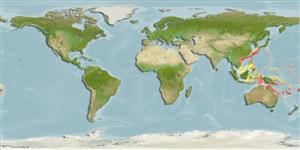>
Perciformes/Serranoidei (Groupers) >
Anthiadidae (Fairy basslets or Streamer basses)
Etymology: Plectranthias: Greek, plektron = anyhting to strike with, spur + Greek, anthias = a fish, Sparus aurata (Ref. 45335).
Environment: milieu / climate zone / depth range / distribution range
Ecología
marino asociado a arrecife; rango de profundidad 80 - 300 m (Ref. 26833). Subtropical
Western Pacific.
Tamaño / Peso / Age
Maturity: Lm ? range ? - ? cm
Max length : 11.1 cm SL macho / no sexado; (Ref. 40960)
Radios blandos dorsales (total): 17. Body moderately deep, depth 2.3 in SL. Head not completely scaled. Ventral margin of preopercle with no antrorse spine (Ref. 43101). Second soft dorsal not filamentous and third dorsal spine longest. Second branched caudal rays filamentous and a small red spot on the upper base of caudal fin. Body with 2 oblique red bands and a third narrow one from eye to thorax (Ref. 26833).
Life cycle and mating behavior
Madurez | Reproducción | Puesta | Huevos | Fecundidad | Larva
Chen, J.-P. and K.-T. Shao, 2002. Plectranthias sheni, a new species and P. kamii, a new record of anthiine fishes (Perciformes: Serranidae) from Taiwan. Zool. Stud. 41(1):63-68. (Ref. 43101)
IUCN Red List Status (Ref. 130435)
Threat to humans
Harmless
Human uses
Más información
Nombres comunesSinónimosMetabolismoDespredadoresEcotoxicologíaReproducciónMadurezPuestaAgregación para la puestaFecundidadHuevosEgg development
ReferenciasAcuiculturaPerfil de acuiculturaRazasGenéticaElectrophoresesheritabilidadEnfermedadesProcesamientoNutrientsMass conversion
Herramientas
Special reports
Download XML
Fuentes de Internet
Estimates based on models
Preferred temperature (Ref.
123201): 16.7 - 26.4, mean 20.2 °C (based on 75 cells).
Phylogenetic diversity index (Ref.
82804): PD
50 = 0.5000 [Uniqueness, from 0.5 = low to 2.0 = high].
Nivel trófico (Ref.
69278): 4.0 ±0.6 se; based on size and trophs of closest relatives
Resiliencia (Ref.
120179): Alto, población duplicada en un tiempo mínimo inferior a 15 meses (Preliminary K or Fecundity.).
Fishing Vulnerability (Ref.
59153): Low vulnerability (10 of 100).
